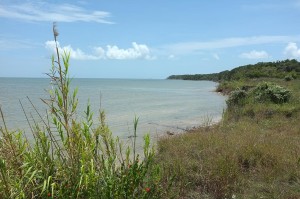The Whooping Crane is North America’s tallest bird at almost five feet, with broad white wings that stretch more than seven feet. The last remaining wild flock makes its winter home at the Aransas Refuge before heading to Wood Buffalo National Park in Canada for the summer to breed. They begin arriving at Aransas in mid-October and depart around the end of March. The flock got down to as low as 15 birds in the 1940s but recovery efforts have since built their numbers up to more than 250.
From the observation towers on the refuge, you can watch them wading in the coastal saltwater marshes or flying above the shoreline, but to get a closer look you’ll need to take one of the boating tours available near the park.
While the cranes attract the bulk of refuge visitors, the 115,000-acre park has many other charms. The Whooping Crane is just one of more than 400 species of birds that visit the refuge, including many waterfowl and neotropic migrants. Alligators slither through its marshes, while deer, javelina, fox and bobcats roam its oak woodlands and grassy meadows.
An auto tour circles 16 miles of the park, beginning along the coastal marshes and protected bays that lie behind Matagorda Island. Once you pass the park’s impressive observation towers, the road becomes one-way and the terrain changes to oak savannah and prairie. In the spring, the meadows burst with colorful Texas wildflowers. Even in late summer, stretches of the road are lined with tall black-eyed susans.
A number of short walks and hikes branch off from the auto tour.
The Dagger Point Trail winds about a mile through an oak and red bay forest before opening onto the bay, its sandy shore strewn with the weathered remnants of the trees that have tumbled into the water.
The Big Tree Trail (0.7 mile) crosses through a woodland of tall live oaks, the largest of which is nearly 500 years old.
The Bay Overlook is just a brief walk to a sandy hill overlooking San Antonio Bay, but equally stunning – just short of the overlook – is a huge live oak covered in vines to create a shady “room” – and welcome relief during hot weather.
Two short birding trails – both less than a mile – cross through woodlands that are a haven for migratory songbirds.
There are three freshwater ponds off the auto tour – or at least there were. For now, the drought had dried up Frog Pond, Jones Lake, Hog Lake and many of the sloughs along the Heron Flats Trail (1.4 miles). In wetter times, they attract a variety of herons, egrets and other wading birds.
Even when there aren’t birds to watch, the park’s two silvery observation towers are worth the climb. From a distance they resemble an old amusement park ride. From the top, you can see the bay and coastal wetlands on one side and oak forest stretching into the distance on the other. A long, narrow boardwalk leads from the observation towers through the marsh to the shore and connects up with the Big Tree Trail, but recently, most of it was closed for repairs.
REFUGE GALLERY










